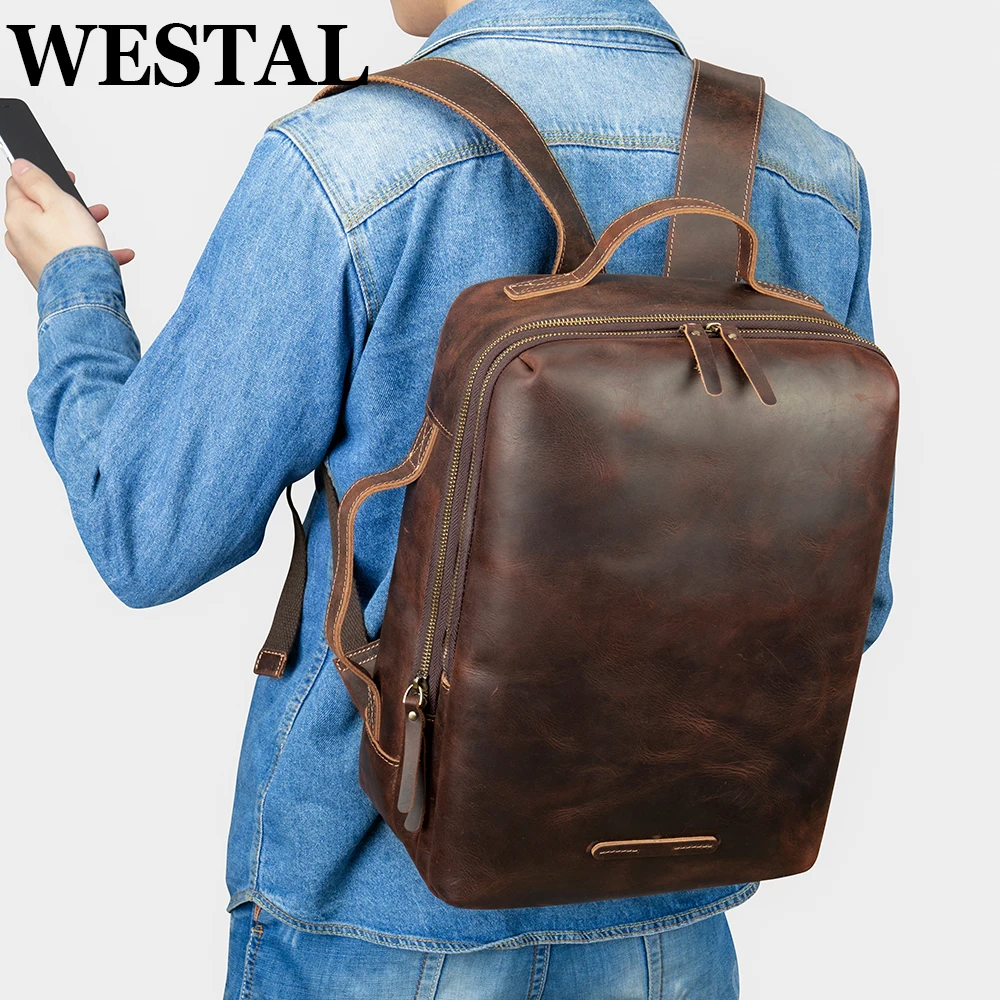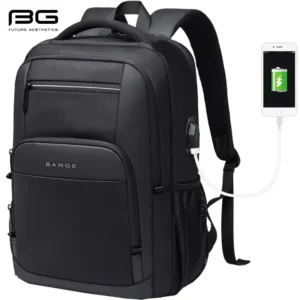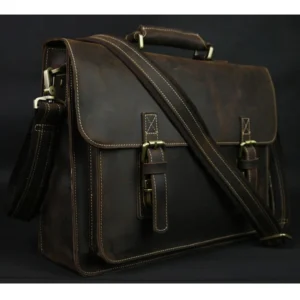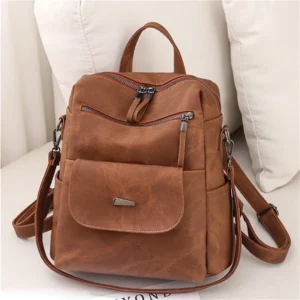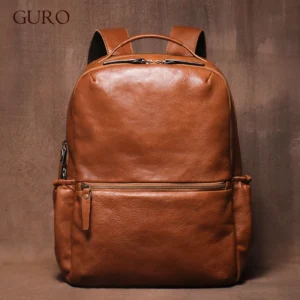1. Understanding Full-Grain Leather: The Premium Choice
When exploring high-quality backpack materials, full-grain leather stands at the top of the hierarchy. This premium material comes from the uppermost layer of the animal hide, keeping the natural grain and texture completely intact. Unlike other leather types, full-grain undergoes minimal processing—the hide isn’t sanded, buffed, or altered to remove imperfections.
What makes full-grain leather immediately recognizable is its distinctive characteristics:
- Visible natural markings, scars, and grain patterns that tell a story
- Dense, tight fiber structure that provides exceptional strength
- Slight variations in texture across the surface
- A rich, organic smell that’s unmistakably genuine
Full-grain leather represents the most authentic form of leather available for backpacks. Its minimal processing preserves the hide’s natural strength and character, allowing the fundamental differences between leather types to become apparent even to untrained eyes. The natural grain acts as a protective barrier against moisture and dirt while showcasing unique patterns that become more pronounced over time.
The premium nature of full-grain leather makes it an exceptional choice for backpacks designed to last through years of daily use while developing character that can’t be replicated artificially.
2. The Unmatched Durability of Full-Grain Leather Backpacks
The exceptional durability of full-grain leather comes from its inherent structural integrity. Unlike processed leathers, full-grain retains the densest and strongest part of the hide with its fibers intact and unaltered. This natural strength translates into practical benefits that make it ideal for backpacks:
- Superior tear resistance that prevents ripping at stress points like handles and straps
- Exceptional puncture resistance that protects against accidental damage
- High abrasion tolerance that withstands daily friction against various surfaces
- Impressive tensile strength that maintains structural integrity even when fully loaded
What’s truly remarkable about full-grain leather is how it actually strengthens with use. The natural oils in the material redistribute through regular handling, and the fibers compact and settle into optimal positions. A well-made full-grain leather backpack can easily last 15-20 years or more with proper care, making it a companion for decades rather than seasons.
Historically, full-grain leather was the material of choice for items requiring extreme durability—from saddles bearing tremendous weight to boots worn in harsh conditions. This same legacy of resilience makes durable bags crafted from full-grain leather exceptionally dependable for everyday use.
For those seeking the ultimate in longevity, our collection of full-grain leather backpacks showcases how this premium material can be transformed into everyday carriers that withstand the test of time.
3. Aesthetic Evolution: The Patina Development Process
One of the most cherished qualities of full-grain leather is its ability to develop a patina—a glossy surface that forms gradually through use, handling, and exposure to environmental elements. This natural aging process creates a visual story that’s unique to each backpack and its owner.
When new, full-grain leather typically has a somewhat uniform color with subtle variations. Over time, remarkable changes occur:
- Areas frequently touched by hands develop a warmer, richer tone from natural skin oils
- Exposed edges and corners may darken and develop a polished appearance
- The overall color deepens and becomes more complex with subtle variations
- Light scratches blend into the surface, adding character rather than detracting from beauty
Unlike synthetic materials that simply wear out or look damaged with age, full-grain leather evolves into something more beautiful than its original state. This transformation can’t be rushed or artificially replicated—it represents a genuine record of the backpack’s journey with you.
The beauty of patina development lies in its personalized nature. Two identical backpacks will develop completely different characteristics based on how they’re used, creating what many leather enthusiasts consider a living document of your experiences. Understanding the art of patina on full-grain leather helps appreciate why this quality is so highly valued by discerning backpack owners.
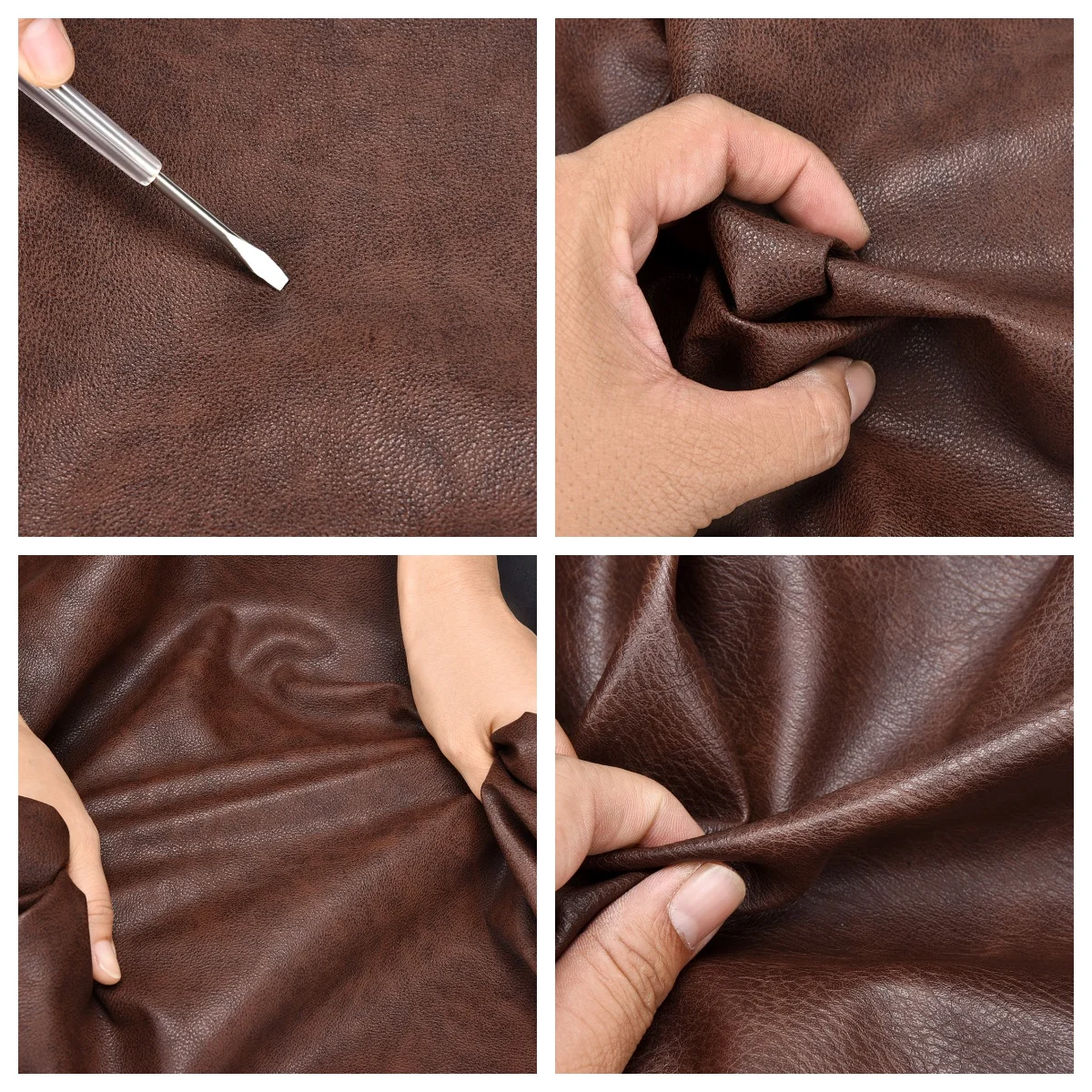
4. Practical Benefits: Comfort and Functionality Features
Beyond durability and aesthetics, full-grain leather offers practical advantages that enhance the everyday carrying experience:
• Natural Breathability: The microscopic pores in full-grain leather allow air circulation, preventing the clammy feeling common with synthetic materials and reducing odor buildup over time.
• Conforming Comfort: With regular use, full-grain leather gradually molds to your body’s contours, creating customized comfort that improves rather than deteriorates over time.
• Inherent Water Resistance: Though not completely waterproof without treatment, quality full-grain leather naturally repels light moisture and dries without damage when properly cared for.
• Temperature Regulation: Leather provides insulation in cold weather while allowing heat dissipation in warmer conditions, making it comfortable year-round.
• Sensory Appeal: The distinctive natural scent and satisfying tactile experience of full-grain leather create a premium sensory experience that synthetic materials can’t replicate.
For daily use, these properties make durable leather commuter backpacks particularly appealing. The material naturally adapts to your carrying habits, becoming more comfortable rather than breaking down over time. Unlike synthetic backpacks that often feel clammy against the back during physical activity, full-grain leather maintains breathability while providing structure and support.
5. Full-Grain vs. Top-Grain Leather: Key Differences for Backpacks
When evaluating premium leather backpacks, the choice often narrows down to full-grain versus top-grain leather. Understanding their differences is crucial for making an informed decision:
| Feature | Full-Grain Leather | Top-Grain Leather |
|---|---|---|
| Processing | Unaltered natural surface | Top surface sanded to remove imperfections |
| Appearance | Natural variations, marks, and character | More uniform, consistent look |
| Durability | Maximum possible strength | Very good, but slightly reduced from sanding |
| Breathability | Excellent air circulation | Good, but somewhat diminished |
| Patina Development | Develops rich, dramatic patina | Develops lighter, more subtle patina |
| Price | Highest cost | High cost, but less than full-grain |
| Weight | Typically heavier | Slightly lighter due to thinning |
Full-grain leather maintains its complete natural structure, preserving the hide’s strongest fibers and natural barriers. In contrast, top-grain leather undergoes a process where the surface is slightly sanded to remove imperfections, creating a more uniform appearance but slightly reducing its inherent strength.
For backpacks intended for heavy use or decades of service, these differences become significant. Full-grain leather offers superior tensile strength and tear resistance, making it ideal for load-bearing straps and high-stress areas. Top-grain leather provides excellent durability with a more refined, consistent appearance that some prefer aesthetically.
The differences between full-grain and top-grain leather become most apparent over years of use. Full-grain develops a more pronounced character with deeper color variations, while top-grain ages more subtly. Both are excellent choices, but full-grain represents the ultimate in longevity for backpacks subjected to regular use.
6. How Full-Grain Leather Compares to Genuine & Bonded Leathers
Moving down the leather quality hierarchy, “genuine leather” and “bonded leather” represent significantly different value propositions compared to full-grain:
| Leather Type | Construction | Durability | Appearance | Typical Lifespan |
|---|---|---|---|---|
| Full-Grain | Complete top layer with natural grain intact | Excellent | Develops rich patina | 15-30+ years |
| Genuine Leather | Split leather from lower layers | Fair to good | Limited patina development | 5-10 years |
| Bonded Leather | Reconstituted leather scraps with polyurethane coating | Poor | Deteriorates rather than improves | 2-5 years |
“Genuine leather,” despite sounding premium, actually indicates the third grade of leather quality. It typically comes from the split layers beneath the top grain and lacks the fiber strength and natural characteristics of full-grain. For backpacks, this translates to significantly reduced durability and minimal patina development.
Bonded leather represents the lowest quality option, constructed from shredded leather scraps mixed with adhesives and coated with polyurethane. While technically containing leather, bonded leather backpacks often begin peeling and cracking within a year of regular use.
The price differences between these materials typically don’t reflect their vast quality gap. A genuine leather backpack might cost 30-50% less than full-grain, but last only a third as long. Bonded leather products are substantially cheaper but represent poor long-term value given their short lifespan.
Understanding the four grades of leather quality helps explain why full-grain commands premium pricing—it’s the only option that truly improves with age rather than deteriorating.
7. Full-Grain Leather vs. Synthetic Materials: An Honest Assessment
Comparing natural full-grain leather to modern synthetic materials reveals distinct advantages for each, depending on specific needs and priorities:
Full-Grain Leather Advantages:
- Exceptional longevity (decades versus years for synthetics)
- Improves aesthetically with age rather than deteriorating
- Natural biodegradability at end of life
- Develops unique character specific to the user
- Superior tear and puncture resistance
Synthetic Material Advantages:
- Lighter weight (often 30-50% lighter than comparable leather)
- Lower initial cost
- Complete waterproofing options available
- Wider color selection and consistency
- Minimal maintenance requirements
In certain scenarios—extreme weather conditions, ultralight backpacking, or vegan lifestyles—synthetic materials present clear advantages. However, the environmental calculation isn’t straightforward: while leather comes from animals, quality full-grain leather products often outlast multiple synthetic replacements, potentially reducing overall resource consumption and landfill impact.
From a cost perspective, premium synthetic backpacks might range from $80-200, while comparable full-grain leather options typically start around $250-300. However, when calculating cost-per-year over the product’s lifespan, leather often proves more economical despite the higher upfront investment.
For most everyday and professional uses, the quality factors in leather backpacks make full-grain leather the superior long-term choice, particularly for those who value aesthetics and lasting performance over minimum weight or initial cost savings.
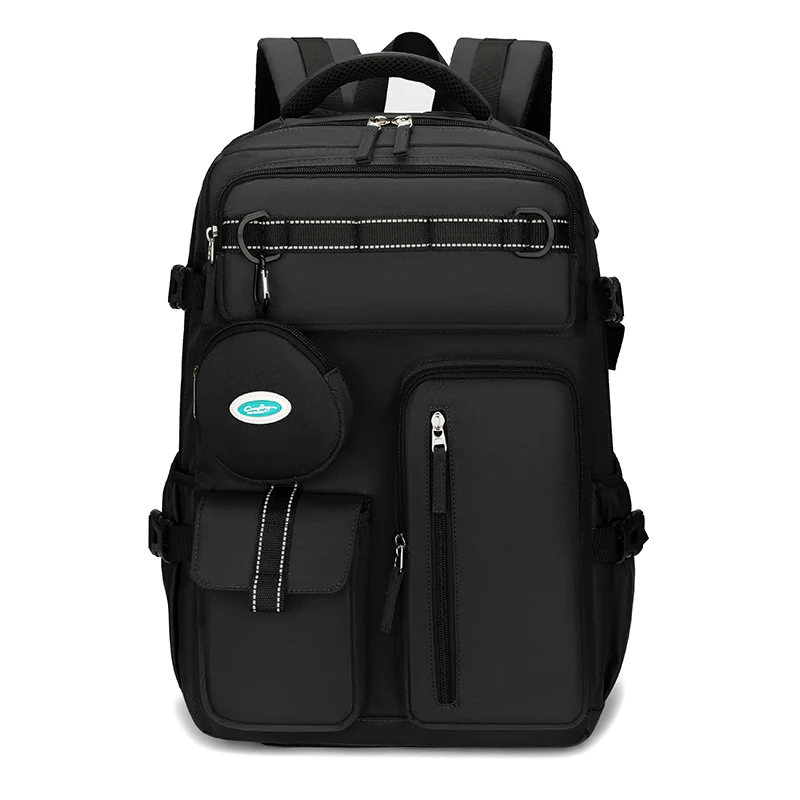
8. The Investment Perspective: Long-Term Value of Full-Grain Leather Backpacks
Approaching a full-grain leather backpack as a long-term investment rather than a simple purchase reveals its true value proposition. Consider this practical cost analysis:
A quality full-grain leather backpack typically costs between $250-500. With proper care, it easily lasts 15+ years of regular use. This calculates to approximately $17-33 per year of service.
In contrast, even good synthetic backpacks ($80-150) typically need replacement every 3-5 years with regular use, resulting in a similar or higher annual cost ($16-50 per year) while never achieving the aesthetic appeal of aged leather.
Beyond simple durability, full-grain leather backpacks offer additional economic advantages:
- Repairability: Quality leather can be professionally repaired if damaged, extending lifespan even further
- Stable appearance: Classic leather designs remain professional and stylish for decades, avoiding trend obsolescence
- Resale value: Well-maintained full-grain leather backpacks can retain 30-60% of their value after years of use
The environmental dimension also warrants consideration. While leather production has environmental impacts, buying one quality product that lasts decades creates substantially less waste than cycling through multiple replacements. This “buy once, cry once” philosophy reduces overall consumption and waste generation.
While considering these advantages, it’s also important to understand potential disadvantages of full-grain leather to make a fully informed investment decision based on your specific needs and priorities.
9. Essential Care Guide: Maintaining Your Full-Grain Leather Backpack
Proper maintenance dramatically extends the life of full-grain leather while enhancing its appearance. Following these essential care procedures ensures your backpack remains beautiful and functional for years:
Regular Cleaning (Every 1-2 Months)
• Gently remove surface dust with a soft cloth
• Clean with a slightly damp cloth or specialized leather cleaner
• Never use household soaps, detergents, or harsh chemicals
• Allow to dry naturally away from direct heat sources
Conditioning (Every 3-6 Months)
• Apply quality leather conditioner with a soft cloth using circular motions
• Focus on seams and high-flex areas that dry out fastest
• Allow conditioner to absorb fully (typically 12-24 hours)
• Buff gently with a clean cloth to remove excess
Waterproofing (Every 6-12 Months)
• Apply specialized leather waterproofing product
• Test on an inconspicuous area first
• Apply thin, even coats rather than a single heavy application
• Allow full drying time between coats
Storage When Not In Use
• Store in a breathable cloth bag, never plastic
• Keep in moderate temperature and humidity
• Stuff with paper to maintain shape if storing long-term
• Keep away from direct sunlight to prevent uneven fading
Understanding how to maintain a leather backpack properly is essential for protecting your investment. With regular care, our leather laptop backpacks and other full-grain products develop beautiful patina while maintaining their structural integrity, often looking better after years of use than when first purchased.
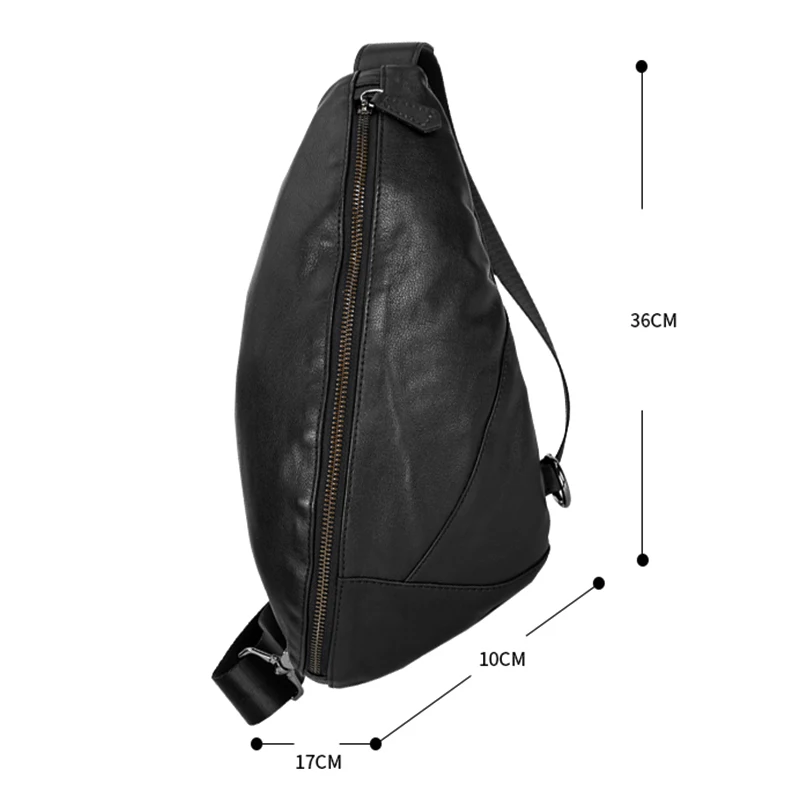
10. Is a Full-Grain Leather Backpack Right for You? Decision Factors
Determining whether a full-grain leather backpack suits your needs requires honest assessment of several key factors:
Lifestyle Compatibility
• Do you need a backpack that can transition between casual and professional settings?
• Are you looking for something that will serve you reliably for many years?
• Do you appreciate products that develop unique character over time?
Investment Mindset
• Are you willing to pay more upfront for longer-term value?
• Do you view backpacks as consumable items or potential heirlooms?
• Can you appreciate the economic logic of buying one excellent product rather than several adequate ones?
Aesthetic Preferences
• Do you prefer natural materials that develop patina over those that remain unchanged?
• Are you drawn to classic, timeless designs over contemporary trends?
• Do you value the tactile experience of your everyday items?
Maintenance Willingness
• Are you able to perform basic leather care several times per year?
• Will you remember to protect your backpack from extended exposure to harsh elements?
• Do you see maintenance as satisfying care or bothersome work?
Physical Considerations
• Are you comfortable with a backpack that weighs slightly more than synthetic alternatives?
• Do you need extreme water resistance for regular outdoor adventures?
• Will you be carrying very heavy loads where every ounce matters?
Choosing quality leather for bags involves balancing these considerations against your personal priorities. For many, our vintage leather backpacks provide the perfect combination of durability, timeless style, and character development that makes full-grain leather worth the investment.
14 Inch Leather Laptop Backpack, Brown Leather Backpack, Men's Leather Backpack, Vintage Leather Backpack
Price range: $177.28 through $199.12 Select options This product has multiple variants. The options may be chosen on the product pageDesigner Men's Backpack, Men's Leather Laptop Backpack, Men's Leather Work Backpack
Price range: $158.04 through $160.04 Select options This product has multiple variants. The options may be chosen on the product page15 Inch Leather Laptop Backpack, Leather Briefcase Backpack
$332.96 Select options This product has multiple variants. The options may be chosen on the product page17 Inch Leather Laptop Backpack, Men's Leather Travel Backpack, Men's Leather Work Backpack
Price range: $106.28 through $143.88 Select options This product has multiple variants. The options may be chosen on the product pageBrown Leather Backpack, Women's Leather Backpack
$112.16 Select options This product has multiple variants. The options may be chosen on the product pageFull Grain Leather Backpack, Men's Leather Laptop Backpack, Men's Leather Work Backpack
$353.46 Select options This product has multiple variants. The options may be chosen on the product page
11. Common Questions: Water Resistance of Full-Grain Leather Backpacks
Many prospective buyers wonder about how full-grain leather handles moisture exposure. While not naturally waterproof, quality full-grain leather does offer inherent water resistance:
Full-grain leather has natural water-repellent properties due to its dense fiber structure and the remaining natural oils from proper tanning. Light rain or brief exposure to moisture will typically bead on the surface rather than immediately soaking through.
For enhanced protection, specialized leather waterproofing treatments create an invisible barrier that significantly improves water resistance without changing the leather’s appearance or breathability. These treatments need periodic reapplication, typically every 6-12 months depending on usage.
If your backpack does get caught in heavy rain, proper drying is crucial: blot (don’t rub) excess water with an absorbent cloth, stuff with paper to maintain shape, and allow to dry slowly at room temperature. Once fully dry, conditioning will restore moisture balance to the leather.
Our men’s leather backpacks balance natural water resistance with practical functionality, making them suitable for everyday use in varied conditions when properly maintained.
12. Does Full-Grain Leather Get Better With Age?
Unlike most materials that deteriorate over time, full-grain leather genuinely improves with use—a quality leather enthusiasts prize above all others.
New full-grain leather begins somewhat stiff with a uniform appearance. Within the first month of regular use, you’ll notice it becoming more supple as the fibers flex and natural oils redistribute. By six months, high-contact areas develop subtle sheen and slightly deeper coloration.
After a full year, more significant transformation occurs—edges and corners develop darker patina, the overall color deepens, and the material conforms perfectly to your usage patterns. At the five-year mark and beyond, full-grain leather reaches its peak beauty, showcasing rich, complex coloration and a natural sheen that cannot be replicated artificially.
This aging process varies based on:
– Exposure to sunlight (accelerates color development)
– Frequency of handling (increases patina in touched areas)
– Natural oils from hands (creates personal patterns of wear)
– Conditioning routine (maintains proper moisture balance)
Understanding that 100% leather isn’t always full-grain helps explain why some leather products don’t improve with age. Our brown leather backpacks showcase particularly dramatic patina development, with the material darkening and developing rich character that makes each piece uniquely beautiful over time.

